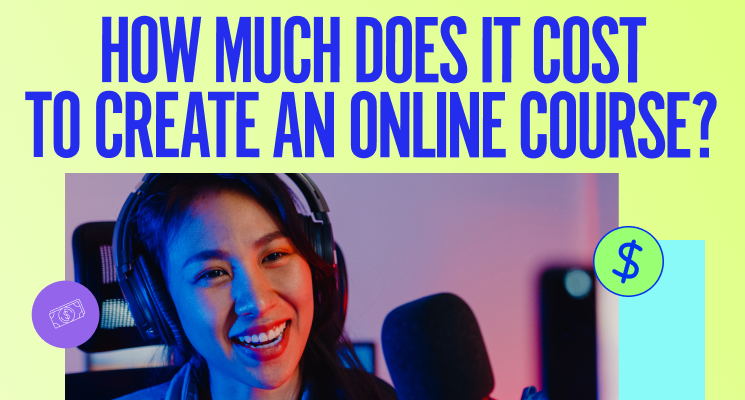
How Much Should I Charge For An Online Course
Get free expert insights and tips to grow your knowledge business sent right to your inbox.
Pricing is one of the most critical factors that determines the success of your online course.
It's a delicate balancing act between perceived value and profitability.
If you price your course too low, you might undervalue your expertise and leave money on the table. If you price it too high, you risk deterring potential learners.
Finding this "sweet spot" is not something that you wake up and decide. So, how do you approach it? Which strategies should you use to know how much to charge for your course?
In this guide, we'll walk you through the key factors to consider when pricing your online course.
Why Is Pricing Your Online Course So Important?
Your price sends a message to potential students about your content's quality, depth, and uniqueness.
Research has even shown how pricing affects perceived value. A study by a professor from The University of Texas at Arlington found that consumers often perceive higher-priced products as superior quality.
Here are four key reasons why pricing your online course is so important:
1. Perception Of Quality
Your course price directly influences how potential students perceive the value of your content.
Setting a higher price signals to potential students that the course offers substantial value and quality content.
A lower price might indicate a basic or introductory-level course.
2. Market Positioning
Your pricing strategy can help position your course within the market.
Are you aiming to be a premium provider in your niche, or are you looking to make your course accessible to as many people as possible?
Your price affects your positioning and determines the students you attract.
3. Revenue Goals
The pricing of your course directly impacts your revenue.
For example, if your goal is to earn $10,000 from your online course within the first year, you'll need to break down this goal into actionable pricing and sales targets.
Let's assume your total costs (including content creation, platform fees, and marketing) are $2,000. After covering your costs, you need to generate $12,000 in sales to meet your revenue goal.
So, to meet these financial goals, you need to find a balance between a price that reflects the value of your course and what your target market is willing to pay.
4. Competitive Edge
Pricing is also a strategic tool in standing out from the competition.
When you research competitor prices, you can position your course to offer more value at a similar price or decide to compete on quality by pricing higher.
Alternatively, you can offer a lower price point to attract those looking for cost-effective solutions.
Not sure if your course will hit the mark? Our free worksheet helps you validate your idea, find your ideal customer, and discover profitable solutions. Start building your business with confidence today!
{{product-idea}}
5 Easy Steps To Pricing Your Online Course

Online pricing strategy is not a one-size-fits-all. Yes, there are guidelines, but do they apply across the board? No.
The general rule is you should sell a mini course for about $47 to $147. A shorter online course costs $197 to $497, and a longer flagship course costs around $1,000 to $3,000. But these are just rough estimates, and the actual pricing of your course should be based on a thorough analysis of various factors.
Why? Because there's no single magic number that works for everyone.
That’s why we want to walk you through a step-by-step process to help you determine the optimal price for your online course.
These steps will guide you through analyzing the critical factors to find the ideal price point for your specific course:
1. Understand Your Market
Imagine trying to sell a course to entry-level employees for thousands of dollars. It wouldn't matter how well-designed your course is. This lack of ideal profiling would lead to failure.
So, the first step when pricing your course is to start by identifying your ideal student.
- Who are they?
- What are their demographics, interests, and pain points?
- What motivates them to seek out an online course like yours?
Once you have a clear picture of your target audience, you can tailor your course content and pricing to meet their needs and expectations.
Ask yourself - who is the perfect person for my course?
Go beyond basic demographics to their needs, goals, and pain points. Are you targeting busy professionals looking to upskill for a promotion?
Or perhaps stay-at-home parents seeking flexible income? The more specific your picture, the better you can price accordingly.
Next, research your competitors. What are similar courses charging, and what do they offer?
Don't simply copy, but understand the range. If your course is far more comprehensive, you have grounds for charging more. Conversely, if you're new and building credibility, start lower.
Let's say you're creating a course on social media marketing. You find that most of your competitors are offering courses priced between $200 and $500.
However, you notice that their courses are primarily text-based and lack practical examples.
You can differentiate your course by including the following:
- Case studies
- Live demonstrations
- Personalized feedback
This will justify a higher price point reflecting your added value.
Other questions to answer when researching the market include:
- Is there a growing need for the skills or knowledge you're teaching?
- Are there market trends or changes that make your course particularly relevant?
- What’s the perceived value of your course in the eyes of your target audience?
Wondering how to stand out in a crowded market? Grab our free guide and learn how to find your niche in less than 10 minutes.
{{find-niche}}
2. Calculate Your Costs
Understanding the costs of creating and running your online course will establish your minimum price point.
Without this knowledge, you risk selling yourself short and losing potential profit.
This calculation involves accounting for both direct costs associated with creating and delivering the course and indirect costs that contribute to the overall running of your business.
Start by considering the direct costs associated with producing your course content.
- Content Creation: This includes expenses related to producing the course materials, such as hiring subject matter experts, videographers, or graphic designers. If you're creating the content yourself, consider the value of your time as well.
- Technology and Tools: Costs for the platform you use to host your course, any software for editing videos or creating course materials, and subscription services for email marketing or project management tools.
- Marketing and Sales: Costs include advertising, promotional materials, and commissions paid to affiliates or partners. It also covers the cost of tools for marketing automation and customer relationship management (CRM).
- Support and Administration: Costs related to customer support, such as hiring staff to answer queries or manage student forums, and administrative costs like accounting or licensing fees.
Next, consider the indirect costs that contribute to the overall value of your course, such as:
- Overhead: These are your general business expenses that aren't directly tied to the production or delivery of your course. They include rent for office space, utilities, and equipment maintenance.
- Professional Development: Costs for your training and development to ensure you stay at the top of your field.
- Website and Hosting: Maintaining a website and ensuring it’s secure and functional is an ongoing expense that supports the delivery of your course. For example, if you host your courses on the Kajabi Growth plan, this cost will be $159 monthly.
To calculate your total costs, sum up all direct and indirect expenses. This total gives you the baseline amount you need to cover through course sales before making a profit.
Then, divide this total by the number of students you expect to enroll to determine your breakeven point, which is the minimum number of students required to cover your costs at a given price point.
Here is an example of pricing for a membership site.
Let’s say you're launching a digital photography membership course. Here are hypothetical costs:
- Content Creation: $2,000
- Technology and Tools: $500
- Marketing and Sales: $1,000
- Support and Administration: $500
- Overhead (indirect costs): $800
- Professional Development (indirect costs): $200
- Website and Hosting (indirect costs): $300
- Total Costs: $5,300
With these costs, you need to generate at least $5,300 from your course to break even. This doesn't yet account for profit, taxes, or unforeseen expenses, which you should consider in your final pricing.
Now, determine how many courses you realistically expect to sell. If you expect to sell 100 courses, you'll need to price each at least $53 to break even ($5,300 / 100).
However, to ensure profitability and cover taxes and unforeseen expenses, double this amount, suggesting a price of $106 or rounding up to a market-friendly $109 or $119.
Also, remember that your costs may vary over time, especially if you update your course content or invest in additional resources to enhance the learning experience. Review and adjust your pricing regularly as needed to ensure you cover your expenses and generate a sustainable profit.
3. Evaluate The Value Of Your Content
The perceived value of your course directly impacts the price you can command.
The value is tied directly to the outcomes it promises and delivers, such as skills acquired, knowledge gained, and opportunities unlocked for your students.
Value evaluation is a deep dive into the intrinsic value your course offers to students and how it stands out from the competition.
When evaluating the value of your content, put yourself in your target audience's shoes.
Ask yourself:
- What transformation or outcome will students achieve by taking my course?
- How will my unique expertise and insights help them get there?
- What makes my course stand out from others in the market?
One, assess how your course stands out from others in the market. Do you offer insights, frameworks, or strategies that can't be easily found elsewhere? The more unique and comprehensive your content, the higher its perceived value.
Two, consider the tangible results and outcomes that your students can expect to achieve by taking your course. The more your course enables students to solve problems, overcome challenges, or reach their goals, the more valuable it becomes.
For example, how much would you sell a course that promises to make someone a master chef?
Third, your expertise and reputation in your field also contribute significantly to the value of your course. The more established and respected you are as an authority, the more students will trust the quality and credibility of your content.
If Gordon Ramsay, a Michelin-starred chef, were to create an online cooking course, he could command way higher prices than a less-experienced chef.
Finally, the level of interaction and personal support you provide to students significantly influences the value of your course.
If you offer personalized feedback, coaching calls, or a dedicated support community, your course becomes more valuable than a self-paced course with limited interaction.
4. Consider Pricing Models
Pricing isn't always about a single number. You can offer various options to give students flexibility and boost your sales potential.
For example, not all students can afford a one-time lump sum payment, especially for more expensive, comprehensive courses.
So, offering flexible payment options makes your course more accessible to a wider audience.
Some popular pricing models include:
Payment Plans
This lets students pay for the course in smaller, more manageable installments.
For instance, instead of charging $600 upfront for a course, you can offer a three-month payment plan of $200 per month.
This makes the course more accessible and attracts students who are hesitant to make a large one-time payment without first experiencing the course.
Tiered Access
You can create different levels of course access at different price points, allowing students to choose the option that best fits their budget and learning needs.
You can offer a basic tier that includes:
- Access to the core course content
- A mid-level tier that adds group coaching calls and a private community
- A premium tier that offers one-on-one coaching and personalized feedback
This way, you cater to different segments of your target audience and increase the perceived value of your higher-priced tiers.
Subscription-Based Pricing
With a subscription model, students pay a recurring fee (monthly or annually) for access to your course content and any ongoing updates or additions.
This works well for courses that cover rapidly evolving topics or provide continuous value through fresh content, live sessions, or community engagement.
For example, if you're teaching a course on social media marketing, a subscription model lets you keep your content up-to-date with the latest platforms, algorithms, and best practices.
Value-Based Pricing
Value-based pricing focuses on setting your price based on your course's perceived value to students rather than solely on your costs or competitors' prices.
This requires a deep understanding of your target audience and the transformation or results they can achieve through your course.
Let's say you offer a course that helps students land their dream job. If your course has a proven track record of helping students secure high-paying positions, you can justify a higher price point based on the tangible value and return on investment your course provides.
Freemium
This is one of the most widely used pricing models. In this model, you offer a portion of your course for free and charge for more advanced content or features.
This model can increase enrollments in the paid segments of your course by building trust and demonstrating value upfront.
Example: If you have a language learning course, offer the first few basic levels for free, then charge a one-time fee or subscription for advanced lessons and features.
5. Test And Adjust
The online course market is dynamic. Your pricing, like your course content, will need to evolve.
It’s not a set-it-and-forget-it thing.
What worked a year ago might not work today. Regularly testing your pricing helps you stay in tune with market trends and consumer willingness to pay.
Also, as you add more content or enhance your course, its value to students increases, so you might need to adjust the price.
Start by launching your course with your initial pricing based on your research, cost analysis, and value assessment.
Then monitor key metrics such as:
- Enrollment rates
- Student feedback
- Revenue generated
These insights will help you gauge the effectiveness of your pricing and identify areas for improvement.
In addition, to ensure you’re not basing your pricing on shallow metrics, you can also use these strategies:

- A/B Testing: Use A/B testing to experiment with different pricing points or models with segments of your audience. A/B testing gives you direct insights into what your potential customers are willing to pay and which pricing structure yields the best conversion rates.
- Survey and Feedback: After course completion, survey your students about their perceptions of value versus cost. This feedback will help you adjust your pricing to match your audience's expectations better.
- Promotional Pricing: Offer limited-time discounts to gauge price sensitivity among potential customers. Monitor the uptake of your course at different price points during these promotions to identify the most attractive pricing strategy.
- Tiered Pricing Adjustments: If you plan on using a tiered pricing model, pay close attention to sales distribution across different tiers. Adjust the features or support offered at each level to better meet your market's needs and expectations.
- Follow-up on Non-Converts: Contact individuals who showed interest in your course but didn’t make a purchase. Inquire about their reasons to get direct insights into pricing barriers.
It's also important to monitor your competitors and market trends.
If you notice a significant shift in competitor pricing or market demand, consider adjusting your pricing to remain competitive and relevant.
Now, when it comes to making pricing adjustments, be strategic and thoughtful. Avoid making drastic changes too frequently, which can confuse or frustrate potential students.
Instead, make incremental adjustments based on data-driven insights and clearly communicate any changes to your audience.
Expert Tip: Use promotions, limited-time offers, or bundling strategies to test different price points and incentivize enrollments. For example, offer a 20% discount for early bird registrations or create a bundle that combines your course with a complementary product or service at a reduced price.
How To Increase The Value Of Your Course
Customers often associate a higher price with more value, but it's not just about the price tag.
The perceived value of your course is influenced by factors like the quality of your content, the uniqueness of your offering, and the tangible results your students can expect to achieve.
This is called the psychology of perceived value.
By focusing on increasing the perceived value of your course, you justify your pricing. That is, when students feel that they are getting exceptional value for their money, they are more likely to enroll in your course, engage with the content, and recommend it to others.
Here are some practical strategies you can implement to enhance the value of your course.
1. Incorporate Real-World Projects And Case Studies
This approach enriches the learning experience and ensures that students can apply what they've learned in practical, tangible ways.
When you solve real-world problems or analyze case studies relevant to your course's subject matter, students gain hands-on experience.
For instance, if you're teaching a course on digital marketing, include a project where students design a comprehensive marketing campaign for a hypothetical or real company.
This could involve:
- Market research
- Defining target audiences
- Creating ad content
- Setting up analytics to measure campaign success
Similarly, use case studies of successful marketing campaigns, including those that faced challenges and how they overcame them. Provide invaluable insights into practical strategies and critical thinking.
2. Include Exclusive Interviews With Industry Experts
Guest lecturers provide cutting-edge information, share personal experiences, and answer questions from their professional viewpoints.
They will offer depth that goes beyond the primary course content.
If your course focuses on entrepreneurship, invite successful entrepreneurs to share their journey, including their challenges and how they navigated them.
Exclusive expert interviews add an element of scarcity and uniqueness to your course. They give your students valuable information and advice they might not have otherwise.
Plus, associating your course with respected industry experts will boost your credibility and authority in your field.
3. Offer Continuous Lifetime Content Updates
You should regularly update your course materials to reflect the latest trends, technologies, and best practices.
This ensures your course remains valuable and attractive to new and returning students.
When students know they can revisit the material at any time and receive new content and resources as you create them, they are more likely to see your course as a long-term investment in their learning and growth.
By providing lifetime access and updates, you demonstrate your ongoing commitment to your student's success and the longevity of your course.
This will help justify a higher price point. Your course will feel like a more valuable and worthwhile investment compared to one-time, static offerings.
4. Integrate Interactive And Personalized Learning Experiences
Personalized learning paths let students focus on areas most relevant to their interests and goals.
Use interactive quizzes, simulations, and games to make learning more engaging, improving retention and understanding.
For example, for an online programming course, you can use interactive coding exercises that give instant feedback.
Depending on their interests, students could also choose different specializations, such as web development, data science, or app development.
5. Create A Private Community For Course Members
A membership community allows students to ask questions, share insights, discuss course topics, and support each other's learning and growth.
As the course creator, you can facilitate discussions, provide additional resources, and offer guidance and feedback within the community.
A community allows students to:
- Network with like-minded individuals
- Learn from each other's experiences and perspectives
- Feel part of a supportive and engaged learning community
This sense of belonging and peer support can increase course completion rates, student satisfaction, and the likelihood of positive word-of-mouth referrals.
With a platform like Kajabi, you can seamlessly implement these strategies.
Kajabi is an all-in-one online course hosting platform that you can use to host your lectures, continuously update content, personalize learning experiences, and build a vibrant community through the community feature. Start your 14-day free trial today.
How To Know If The Price Of Your Online Course Is Right?
Finding the sweet spot that maximizes enrollment and revenue is key to building a sustainable and profitable online course business.
But how do you know if you've hit that pricing sweet spot?
It's not always easy to tell, especially when launching your course.
You may have done your market research, analyzed your costs, and assessed the value of your content, but the true test comes when you put your course out into the world and see how students respond.
And to gauge whether you’ve priced your course appropriately, you'll need to pay attention to several key indicators.
1. Enrollment Rates
Your course's enrollment rate is one of the most direct indicators of correct pricing.
If your course consistently meets or exceeds your enrollment targets, it's a strong sign that your pricing aligns with the market's expectations.
But if enrollments are lagging, it’s likely your course is perceived as too expensive for the value it provides.
So, monitor these trends over time and in response to marketing efforts to get the most accurate picture.
2. Student Feedback
Listen to your students to get insights into your course's pricing.
Positive feedback on the course content and its outcomes, coupled with affirmations that the price was worth the investment, indicates that your pricing is on point.
If students express dissatisfaction about the cost versus value received, reassess your pricing or use the ways we have discussed above to enhance the perceived value of your course.
3. Comparison With Competitors
Monitor your competitors' pricing and offerings to understand where your course stands.
It could affect enrollments if you offer similar or additional value compared to competitors, but your course is priced significantly higher or lower.
Your course should be competitively priced, reflecting unique value propositions or additional content that justify a higher price point.
4. Repeat Customers And Referrals
A high rate of repeat customers or referrals indicates that your students perceive your course as valuable and appropriately priced.
Satisfied students are more likely to enroll in other courses you offer and recommend your course to others.
5. Profitability And Sustainability
Ultimately, the right price for your course should ensure profitability and sustainability for your business.
If you can cover all costs associated with creating and marketing your course, pay yourself a fair wage, and reinvest in your business, you've likely found a sustainable price point.
However, you should adjust your pricing if you're struggling to meet these financial goals.
Final Thoughts
Pricing your online course requires a thoughtful, data-driven approach that considers your target audience, course content, market dynamics, and business goals.
By investing time and effort into researching your market, assessing your costs and value, and testing and refining your pricing strategy, you can set your course up for long-term success and profitability.
The right price should balance attracting and serving your target students and generating sustainable revenue.
Also, remember that pricing your course effectively is an ongoing process that requires continuous learning, experimentation, and improvement.
With an online course hosting platform like Kajabi, you can easily create and host your course content, market your offerings, and manage your sales and student interactions — all in one place.
Sign up for a free trial of Kajabi today and see how our platform can help you price your course for maximum impact and profitability.
How Much Should I Charge For An Online Course: Frequently Asked Questions
Can I Change The Price Of My Online Course After Launching?
Yes, you can adjust prices based on market demand, course updates, or promotional strategies. However, be mindful of how price changes may impact existing students. Communicate these changes clearly to them to maintain trust.
How Can I Justify A Higher Price For My Course?
To justify a higher price for your course, focus on delivering high-quality content, unique value propositions, and tangible outcomes for your students. Include expert guest speakers, provide exceptional support, offer certificates of completion, and showcase successful student testimonials to substantiate a higher price.
What Factors Should Influence My Course Pricing?
- Costs of Production: The total cost of creating and delivering your course.
- Market Demand: The demand for the subject matter or skills your course offers.
- Competition: Prices of similar courses in the market and how your course compares in value.
- Target Audience: The financial capacity and willingness to pay of your intended students.
- Course Outcomes: The tangible benefits or transformations students will achieve by taking your course.
- Content Quality and Uniqueness: The depth, relevance, and exclusivity of your course content.













